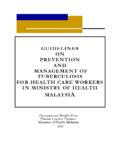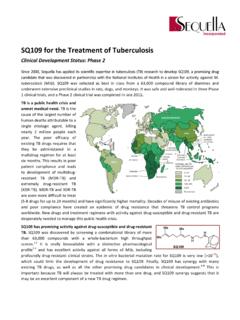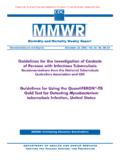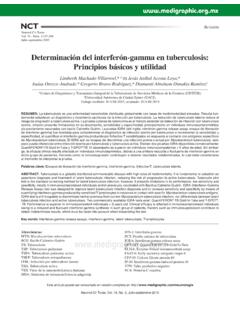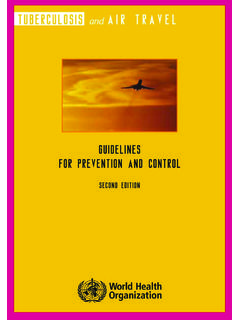Transcription of Malawi TB infection control guidelines 2008 - WHO
1 guidelines FOR infection PREVENTION AND control FOR TB INCLUDING MDR-TB AND XDR-TB. JULY, 2008 2 iFOREWORD tuberculosis is still one of the leading causes of morbidity and mortality in Malawi despite the fact that it can be cured with adequate treatment. The emergence of multi drug resistant tuberculosis (MDR-TB) is one of the challenges in our efforts to control TB. Health care workers in most facilities are at high risk of becoming infected with tuberculosis (nosocomial transmission) especially when they have immuno-suppression due to the human immuno-deficiency Virus (HIV). It is therefore very important to have guidelines for infection prevention and control for a better understanding in the context of health care settings on issues of TB transmission. Preventive and control measures to reduce the risk of TB infection and protection of health care workers should be given highest priority in health care planning and development.
2 HIV testing and counseling (HTC) should be encouraged among health care workers in order to ensure that they benefit from preventive therapy, Anti-retroviral drugs and psychosocial support. These infection prevention and control (IPC) guidelines aim at increasing awareness of TB in staff and its prevention. It is meant to be used by all health care workers in health facilities in Malawi , and can also be used to teach IPC in health care schools and colleges. This document is for health care managers, health care workers, administrators, and stakeholders in the public, private, and nongovernmental health sector involved in providing care and treatment to persons with TB and or HIV and AIDS. It can also be helpful for persons or institutions responsible for the health and wellbeing of large numbers of persons living with HIV and AIDS (PLWHA). Settings include HTC centres, community-based outreach centres, ARV and HIV care clinics, hospices, general health care facilities, and correctional institutions such as prisons.
3 The Ministry of Health continues to assist health facility personnel and pledges to continue supervision at all levels to ensure that these guidelines are adhered to by all health care workers. We hope that by following these guidelines it will be possible to achieve our goal of reducing the spread of tuberculosis in the country. Professor Salaniponi Director National TB control Programme Ministry of Health iiAcknowledgements Ministry of Health would like to thank the following for developing this document without whose contributions these guidelines could not have been put together FML Salaniponi, I Idana, JH Kwanjana, GB Samuti, MM Kagoli, A. Mwale, R. Banda, P Chirwa, IL Dambe, N. Mphasa, A. Dimba, I. Nyasulu, DS Nyangulu, A. Phoya, G. Bamusi, B. Upindi, T. Rashidi, H. Mgawi, I. Chelewani, J. Michongwe, EP Chipinga, JR Kandulu, A. Makwakwa, H. Kanyerere, R.
4 Mwenda and B. Chilima The ministry is indebted to TB CAP for their financial assistance in the development and printing of these guidelines . The Ministry would also like to acknowledge the technical assistance offered by WHO. iiiAbbreviations AIDS Acquired Immunodeficiency Syndrome ARV Anti-retroviral BCG Bacillus Calmette Guerin DHO District Health Officer DOTS Directly Observed Therapy Short course Strategy DTO District tuberculosis Officer HCW Health Care Worker HEPA HIV Human Immunodeficiency Virus HTC HIV Testing and Counseling IPC infection Prevention and control LTBI Latent tuberculosis infection MDR-TB Multi-drug Resistant
5 tuberculosis NTP National tuberculosis control Programme PMTCT Prevention from Mother to Child Transmission PLWHA People Living with HIV/AIDS TB tuberculosis TB CAP tuberculosis Coalition Assistance Programme UVGI XDR-TB Extensively Drug Resistant tuberculosis ivTABLE OF CONTENTS FOREWORD ..i ii Abbreviations .. iii TABLE OF iv PREFACE .. v CHAPTER 1 ..6 INTRODUCTION .. 6 CAUSE OF tuberculosis AND ITS 6 THE DIFFERENCE BETWEEN TB infection AND TB DISEASE .. 6 TB IN HEALTH CARE 7 DIAGNOSIS OF PULMONARY TB .. 8 CHAPTER 2 ..9 HOW TO REDUCE THE RISK OF SPREADING M. tuberculosis 9 WORK PRACTICE (AND ADMINISTRATIVE) CONTROLS .. 9 TB infection PREVENTION AND control PLAN .. 10 ADMINISTRATIVE 11 TRAINING OF STAFF .. 11 EDUCATION OF PATIENTS AND COMMUNITY AWARENESS .. 12 TB/HIV COLLABORATION.
6 12 ENVIRONMENTAL control 12 CHAPTER 3 .. 14 CHAPTER 4 .. 15 PROTECTION OF HEALTH CARE WORKERS AND 15 INCREASING AWARENESS OF TB IN HEALTH CARE WORKERS .. 15 INCREASING ACCESS TO HIV COUNSELLING AND TESTING .. 15 PERSONAL RESPIRATORY 16 Chapter 5.. 17 infection PREVENTION IN SPECIAL CIRCUMSTANCES .. 17 Multi-Drug Resistant TB (MDR-TB) .. 17 Prisons and other Correctional 17 CHAPTER 6 .. 18 Monitoring implementation of TB infection control 18 Determine frequency of the infection control plan .. 18 Evaluate the screening process .. 18 Evaluate the success of referrals to the TB diagnostic 19 Evaluate the training process .. 19 21 List of annexes .. 21 ANNEX Information on Ventilation and 21 Annex 2 Policy and procedures .. 24 Annex 3: Education messages about TB for patients .. 27 vPREFACE The goal of these guidelines is to help management and staff minimize the risk of TB transmission in health care facilities and other facilities where the risk of transmission of TB may be high due to high prevalence of both diagnosed and undiagnosed TB.
7 In this era of increasing access to HIV testing and counseling, care and treatment for people living with HIV, more people living with HIV-associated immuno-suppression are attending health care and community facilities than ever before. Persons, including health care workers, with HIV-associated immuno-suppression are particularly vulnerable to developing TB disease if they become infected with Mycobacterium tuberculosis (the germ that causes TB) as a result of exposure in these settings. This policy aims to give the reader a greater understanding of the following: TB transmission in health care facilities infection prevention and control procedures to reduce the risk of M. tuberculosis transmission in health care facilities. Protection of health care workers and staff through HIV testing and counseling (HTC), increasing awareness of TB in staff and preventive action. Importance of TB infection control in correctional institutions like prisons and other facilities where large numbers of possible TB and HIV infected individuals gather.
8 Multi-drug resistant TB (MDR-TB). 6 CHAPTER 1 INTRODUCTION CAUSE OF tuberculosis AND ITS SPREAD tuberculosis (TB) is caused by Mycobacterium tuberculosis (M. Tb). People who have TB disease in their lungs can release tiny particles containing M. Tb into the air by coughing, sneezing, laughing or singing. These particles are called air droplet nuclei. They are invisible to the naked eye. Droplet nuclei can remain airborne in room air for many hours, until they are removed by natural or mechanical ventilation. For TB to spread, there must be a person with TB disease who produces the TB bacilli (the source), and another person who inhales the droplet nuclei containing the bacilli. Although TB is not usually spread by brief contact, anyone who is in close proximity with an infectious person is at risk of getting infected. THE DIFFERENCE BETWEEN TB infection AND TB DISEASE TB infection TB infection is when a person has M.
9 tuberculosis in the body but does not have any symptoms of the TB disease. The bacilli are inactive, but remain alive in the body and can become active later. This condition is also referred to as latent TB infection (LTBI). Only one out of ten people with latent TB will develop TB disease in their lifetime. However this risk increases in persons with dual HIV and TB infection in whom one out of ten will develop TB disease in a year. Isoniazid preventive therapy reduces the risk of developing TB disease. TB Disease A person is said to have TB disease when he or she is infected with M. Tb and shows signs and symptoms of the disease. TB disease mostly occurs in the lungs. A person with TB disease of the lungs (pulmonary TB) usually has persistent cough lasting three weeks or more. General symptoms include fever, sweating at night, loss of appetite, weight loss, fatigue and general constitutional upset.
10 With standard treatment, TB can be cured, even in persons with HIV infection . Untreated, TB is often fatal, especially in persons infected with HIV. In general, a person with TB disease of the lungs or larynx should be considered infectious until his/her sputum smear tests negative on microscopy. 7A TB suspect should be considered infectious until TB is ruled out through sputum smear microscopic examination. TB IN HEALTH CARE SETTINGS TB is a big problem in health care settings. This is because persons with undiagnosed and potentially infectious TB mix with others including those with HIV infection . In high TB burden settings, surveys have shown that up to 10% of persons with HIV infection may have previously undiagnosed TB at the time of HIV Testing and Counseling (HTC), including at centres providing prevention-of-mother-to-child transmission (PMTCT) services. Up to half of these may be infectious TB cases.












